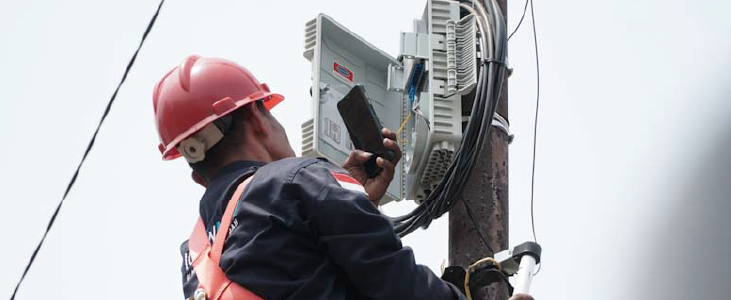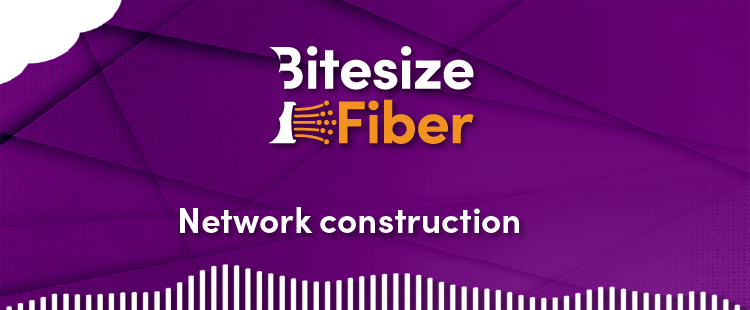Bitesize Fiber: Network operations | Episode 5: AI and the perfect operations workflow
Welcome to Bitesize Fiber, the podcast where we explore the real world challenges and smart solutions shaping the future of fiber and telecom, one bite at a time.
In episode 5 of Bitesize Fiber, host Ellie Puls wraps up the network operations series with experts James Roche and Stefan Schneider. They explore two key topics shaping the future of network operations: cutting through the AI buzz to reveal how it can streamline workflows and boost crew efficiency without data overload, and outlining the blueprint for an ideal workflow—fewer clicks, no delays, and real-time accuracy.
Let's dive in...
Bitesize Fiber: Network operations | Episode 5 transcript
Ellie Puls:
Welcome back to Bitesize Fiber, the podcast where we break down the biggest challenges and best practices in telecom and fiber, one bite at a time. I'm your host, Ellie Puls, and today's episode marks the final chapter in our network operations series. We're diving into two topics with our resident experts, James Roche and Stefan Schneider.
First up, AI and network operations. What's hype, what's helpful, and where AI can actually save crews time in the field without overwhelming them with more data. Then we tackle what the perfect network operations workflow really looks like. Less clicking, fewer delays, and no more chasing down outdated records. Spoiler, it's a lot simpler and smarter than most teams are used to. So if you've ever wondered what a future ready operations model could really look like, you're in the right place. Let's get into it.

|

|

|
| Ellie Puls, Product Manager | James Roche, Customer Success Manager | Stefan Schneider, Product Manager |
Ellie Puls:
You know, now that AI is becoming so prevalent, what do you think would be the most helpful kind of part of network operations that AI could be used in?
James Roche:
I think the optimum use for AI especially from an operation standpoint right now is correlation of past data. So being able to have data in the map or past tickets, something of that nature where a technician can really identify past histories quickly using AI. They don't have to do the research, they don't have to relook at old tickets or read notes. Being able to use AI to say, how many times has someone been at this asset or in this area troubleshooting a similar issue? And it could bring up very specific tickets and it could help them pull in that right stream of data to be able to start to work on that issue. So really the correlation of data I think is the best use for AI right now from an operation standpoint.
Stefan Schneider:
I wholeheartedly agree. Um, in my past life, I had run some, projects and programs and built products that use machine learning for doing data correlation in complex datasets like this. Usually, the target at the time was, hey, let me identify things that are actually events as opposed to noise in the system. Which is one thing that machine learning is really good at. It's identifying patterns and taking the noise out of the pattern to say, hey, this is actually a problem as opposed to, oh, this is just normal behavior of your assets. But that now, it's not sufficient.
You need to correlate it with the history of the assets like James said. But actually go beyond like, this customer actually changed plans recently. Like what is the history of this customer's behavior in the network? Have their habits changed as well? Is their data consumption changed over time? Are they doing things differently?
So being able to see if the problem is actually on the assets on prem or on the path to the customer or somewhere else in the network, so a technician doesn't have to take a very expensive truck roll to a customer's house to just find out that the problem is somewhere upstream, and that that data was available for them to correlate and potentially dispatch someone else. So being able to use, machine learning and AI to correlate things, to summarize tickets, to display anomalies and highlight things that are normal behaviors versus changes in behavior. It's probably the best way to use these technologies when it comes to operations today.
Ellie Puls:
Yeah, that's super interesting. I think AI is going to change the status quo. It'll save everybody time and there's so much data we can analyze.
Stefan Schneider:
I believe so. I think for crews on the field that today, might be thinking I have no idea what to do with AI. If the ability to summarize data from other systems into a cohesive result or summary saves you half an hour on each call, and you're dealing with ten calls a day. That's five hours of your day that you're cutting off from a team and that just grows exponentially with, you know, more complex situations that you have to deal with.
Ellie Puls:
What do you think would be the perfect network operations workflow?
James Roche:
So if I were to design a perfect network operations workflow, it would be something so simple somebody wouldn't believe that it actually needed to be there.
We talk about and a lot of what we do in an operations is time. It's how long does it take you to restore. So when we think about a workflow, if a call comes in, we should have a time to repair. That should be the key date. It shouldn't be something where a technician is clicking, here I am, now I'm going here, now I need to click this, now I need to click this. This kind of ties back into the AI topic where if a technician's got a ticket and he's now on site looking at it, AI should be in the background correlating data for him, him or her, whoever that is. So that they have the tools necessary to do that and it's simple and it's not extensive clicks.
It's not someone in the field because, you get to an outage and you're in a workflow and, oh, I didn't click that I'm here. So now the clock's not ticking, we need to kind of get away from that mindset and say, I've got this ticket, this ticket's been assigned to me, my time to repair is five hours. That includes drive time, that includes troubleshooting, that includes repair. That includes everything in one big bulk kind of move and possibly even use AI to say, this is what they did as well as it went along. So we need to stop making technicians click through things. We need to give them tools readily available so that work gets done with less admin on them.
Ellie Puls:
Yeah, I think those are some of the best products when, you know, it just looks easy. It's like, wow, how is this so simple?
Stefan Schneider:
I think if you take James workflow, and you asked me, what is the best operations workflow that you can design? It's the one that's invisible to the customer and the technician.
So the key becomes letting the computers do what computers do best, which is, manage, identify and process large amounts of data. So technicians can have valuable or related info at their fingertips and then, letting technicians do what they do best, which is taking that data and observing the state of assets and making decisions in real time to quickly repair or bring a customer back. That intuition cannot be replicated, but it can be augmented with better data faster.
Coming up next - Bitesize Fiber: Network construction series, tune in now.
Are your teams struggling with data silos, disconnected systems, or limited access to critical information in the field? IQGeo experts at are here to help. Discover how our solutions can break down barriers and empower your network operations from the control room to the field.


 Previous
Previous







